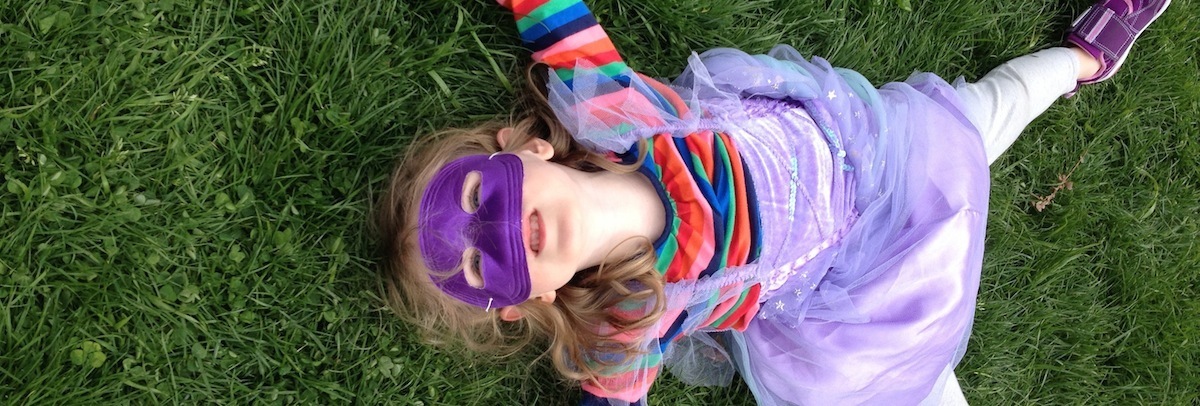Clouds, Rain...and Meatballs?
-
Age: 0 to 8
-
Time: Under 1 hour
-
Materials: dryer balls; blank sheet; twine; umbrella(s); a copy of "Cloudy with a Chance of Meatballs" book
- Skills: Imagination, Active Lifestyle, Creativity, Fine Motor, Gross Motor
An Imaginative Activity Based on "Cloudy…With a Chance of Meatballs"
Few things are more loved by kids than stories and food. In this activity, we leverage both to help kids warm up to a third, and sometimes less beloved, part of life—the weather. In many parts of the world, the winter weather challenges us, kids included. So, winter is the perfect time to use the whimsical book, Cloudy With a Chance of Meatballs, to encourage movement, imaginative play and, hopefully, a bit more love for the weather.
The Guide
- Gather your materials: An old sheet or blanket; at least one, large umbrella (the more the merrier); 2 dryer balls per child (or other soft balls), twine and a copy of Cloudy with a Chance of Meatballs by Judi Barrett. Cut the twine into roughly 1-foot length bits. Without kids noticing, place the balls and twine inside your umbrella, then close it up. Lay the closed umbrella and your sheet just out of sight near wherever you’d like to play.
- Introduce the idea: Wonder together about the weather. “How does the weather feel today?" Continue, "I know a story of a place called Chewandswallow that has really WILD weather all year long! Really WILD! Would you like to see some pictures of this place, Chewandswallow?”
- Read together: Read or take a picture walk through Cloudy With a Chance of Meatballs. As you walk through the book, ask kids guiding questions such as, “What is raining down from the sky in Chewandswallow? Can you imagine? Food falling from the sky? What food would you most like to see fall from the sky?”
- Introduce the play: After enjoying the story, ask kids, “Do you think we should go on a weather walk? Should we bring the umbrella just in case?” Walk to an area in which kids can explore and play freely. Stop them and wonder, “Does anyone hear anything? I’m not sure, but I think I hear some rain coming? Hmm...should I put my umbrella up?” Then, open your umbrella quickly so that all of the balls and twine pieces fall out on you and all around. “Oh my! What is this? Spaghetti and meatballs? Just like in Chewandswallow! Oh dear! What a mess!”
- Pretend together: Continue to pretend that food is falling and that weather is wild in your play. Explore to find more foods, turning different natural objects into different edible precipitation. Acorn caps make a marvelous mushroom monsoon. Fallen leaves make super salad squalls. The kids can decide what different objects could be.
- Clean up and make it storm: Ask your explorers, “Do you think we should collect the meatballs and spaghetti and clean up the mess?" Assuming they are game, start to place a ball or two on the sheet. See if your explorers join you. Once lots of spaghetti and meatballs are on the sheet, explore what storms roll in when you move the sheet up and down.
- Hand over the umbrellas: If you see an opening in kids’ play, ask them, “Would you like to hold an umbrella?” Kids are generally fascinated by umbrellas, and they feel a great deal of agency when we allow them to play with them. Their play with them will be clumsy, but you can support them in joyful risk taking by saying something like, “Umbrellas are so fun, but we have to be careful not to hit another friend. Can you do that?” Then, be prepared to gently remind them or gently help them shift their grip on or placement of the umbrella as needed.
- Let the play roll: No matter how the play unfolds, make sure that the kids are really engaged in what is happening, continue to be silly, and, most importantly, support kids at playing in whichever way they choose. Here are a few fun things to model:
- Throwing balls, leaves, etc. up in the air or off the top of a rock to make it “rain.”
- Toss the balls into an open umbrella—target practice!
- Rolling balls down ramps or any natural incline.
- Hide and find the dryer balls.
- Clean up, make a mess, clean up, repeat.
Why is this activity great for kids?
This lesson combines two very familiar contexts: food and weather, making it easy for kids at different stages of play to pretend and develop their imaginations. A range of simple but compelling materials plus the opportunity to tinker with the objects supports kids with developing creativity. Ball play of various kinds also provides great practice with fine motor skills and hand-eye coordination, in addition to being really darn engaging! The work kids do to disperse, gather and move objects around supports transporting—one of a list of behavioral schema. These schema are patterns of behavior we see in engaged kids’ play all around the world. Finally, hopefully this play context will give you and your kids a way to think more playfully about the weather, helping kids learn to adjust and adapt to whatever falls from the sky!




